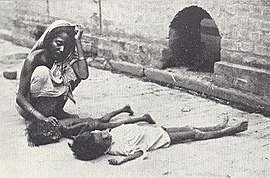
Back مجاعة البنغال 1943 Arabic পঞ্চাশের মন্বন্তর Bengali/Bangla Fam de Bengala del 1943 Catalan Hladomor v Bengálsku 1943 Czech Newyn Bengal 1943 Welsh Den bengalske hungersnød i 1943 Danish Hungersnot in Bengalen 1943 German Λιμός της Βεγγάλης (1943) Greek Hambruna en Bengala de 1943 Spanish قحطی ۱۹۴۳ بنگال Persian
| Bengal famine of 1943 | |
|---|---|
 From the photo spread in The Statesman on 22 August 1943 showing famine conditions in Calcutta. These photographs made world headlines and spurred government action. | |
| Country | British India |
| Location | |
| Period | 1943–1944 |
| Total deaths | Estimated 800,000 to 3.8 million[A] in Bengal alone |
The Bengal famine of 1943 was a famine in the Bengal province of British India (present-day Bangladesh, West Bengal and eastern India) during World War II. An estimated 800,000–3.8 million people died,[A] in the Bengal region (present-day Bangladesh and West Bengal), from starvation, malaria and other diseases aggravated by malnutrition, population displacement, unsanitary conditions, poor British wartime policies and lack of health care.[7] Millions were impoverished as the crisis overwhelmed large segments of the economy and catastrophically disrupted the social fabric. Eventually, families disintegrated; men sold their small farms and left home to look for work or to join the British Indian Army, and women and children became homeless migrants, often travelling to Calcutta or other large cities in search of organised relief.
Bengal's economy had been predominantly agrarian at that time, with between half and three-quarters of the rural poor subsisting in a "semi-starved condition". Stagnant agricultural productivity and a stable land base were unable to cope with a rapidly increasing population, resulting in both long-term decline in per capita availability of rice and growing numbers of the land-poor and landless labourers. A high proportion laboured beneath a chronic and spiralling cycle of debt that ended in debt bondage and the loss of their landholdings due to land grabbing.
The financing of military escalation led to wartime inflation. Many workers received monetary wages rather than payment in kind with a portion of the harvest. When prices rose sharply, their wages failed to follow suit; this drop in real wages left them less able to purchase food. During the Japanese occupation of Burma, many rice imports were lost as the region's market supplies and transport systems were disrupted by British "denial policies" for rice and boats (a "scorched earth" response to the occupation). The British also implemented inflation policies during the war aimed at making more resources available for Allied troops. These policies, along with other economic measures, created the "forced transferences of purchasing power" to the military from ordinary people, reducing their food consumption.[8][9][10] The Bengal Chamber of Commerce (composed mainly of British-owned firms), with the approval of the Government of Bengal, devised a Foodstuffs Scheme to provide preferential distribution of goods and services to workers in high-priority roles such as armed forces, war industries, civil servants and other "priority classes", to prevent them from leaving their positions. These factors were compounded by restricted access to grain: domestic sources were constrained by emergency inter-provincial trade barriers, while aid from Churchill's war cabinet was limited, ostensibly due to a wartime shortage of shipping. More proximate causes included large-scale natural disasters in south-western Bengal (a cyclone, tidal waves and flooding, and rice crop disease). The relative impact of each of these factors on the death toll is a matter of debate.
The provincial government never formally declared a state of famine, and its humanitarian aid was ineffective through the worst months of the crisis. It attempted to fix the price of rice paddy through price controls which resulted in a black market which encouraged sellers to withhold stocks, leading to hyperinflation from speculation and hoarding after controls were abandoned. Aid increased significantly when the British Indian Army took control of funding in October 1943, but effective relief arrived after a record rice harvest that December. Deaths from starvation declined, yet over half the famine-related deaths occurred in 1944 after the food security crisis had abated, as a result of disease. British Prime Minister Winston Churchill has been criticized for his role in the famine, with critics arguing that his war priorities and the refusal to divert food supplies to Bengal significantly worsened the situation.[11][12][13][14]
Cite error: There are <ref group=upper-alpha> tags or {{efn-ua}} templates on this page, but the references will not show without a {{reflist|group=upper-alpha}} template or {{notelist-ua}} template (see the help page).
- ^ Devereux 2000, p. 5.
- ^ A. Sen 1980, p. 202; A. Sen 1981a, p. 201.
- ^ Ó Gráda 2007, p. 19.
- ^ Greenough 1982, pp. 299–309.
- ^ Famine Inquiry Commission 1945a, pp. 109–110.
- ^ Greenough 1982, p. 300.
- ^ "Churchill's legacy leaves Indians questioning his hero status". 20 July 2020. Retrieved 19 June 2024.
- ^ Monbiot, George (30 March 2022). "Putin exploits the lie machine but didn't invent it. British history is also full of untruths". The Guardian. ISSN 0261-3077. Retrieved 1 July 2024.
- ^ "Profit Inflation, Keynes and the Holocaust in Bengal, 1943–44 | Economic and Political Weekly". www.epw.in. 17 October 2018. Retrieved 1 July 2024.
- ^ Patnaik, Utsa (December 2017). "Mr Keynes and the forgotten holocaust in Bengal, 1943–44: Or, the macroeconomics of extreme demand compression". Studies in People's History. 4 (2): 197–210. doi:10.1177/2348448917725856. ISSN 2348-4489.
- ^ Safi, Michael (29 March 2019). "Churchill's policies contributed to 1943 Bengal famine – study". The Guardian. ISSN 0261-3077. Retrieved 19 June 2024.
- ^ "Churchill's legacy leaves Indians questioning his hero status". 20 July 2020. Retrieved 19 June 2024.
- ^ "Remembering WW2's forgotten famine". BBC News. Retrieved 19 June 2024.
- ^ Osborne, Samuel (14 August 2017). "5 of the worst atrocities carried out by British Empire, after 'historical amnesia' claims | The Independent". The Independent. Retrieved 19 June 2024.